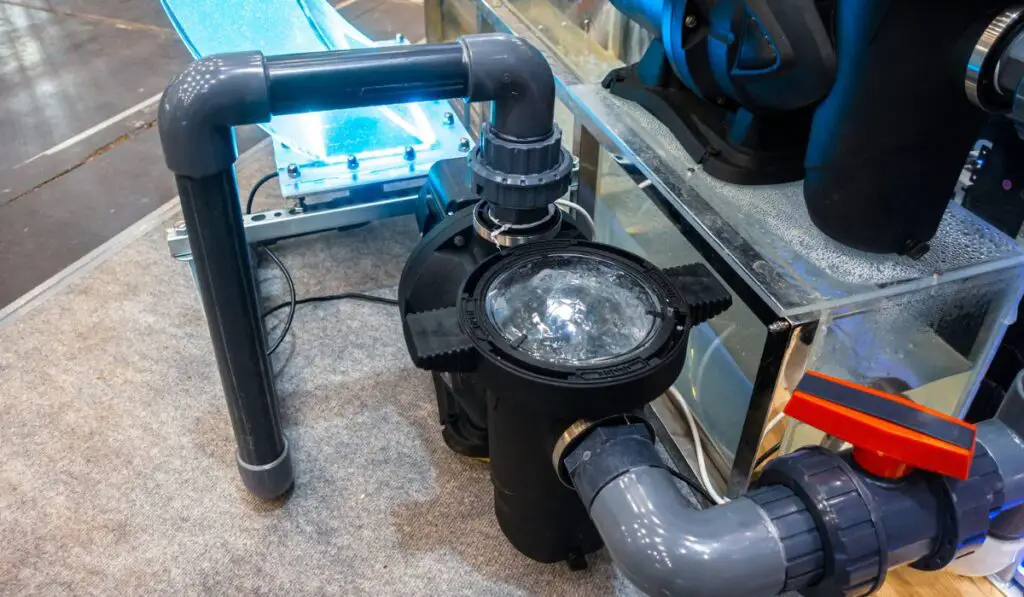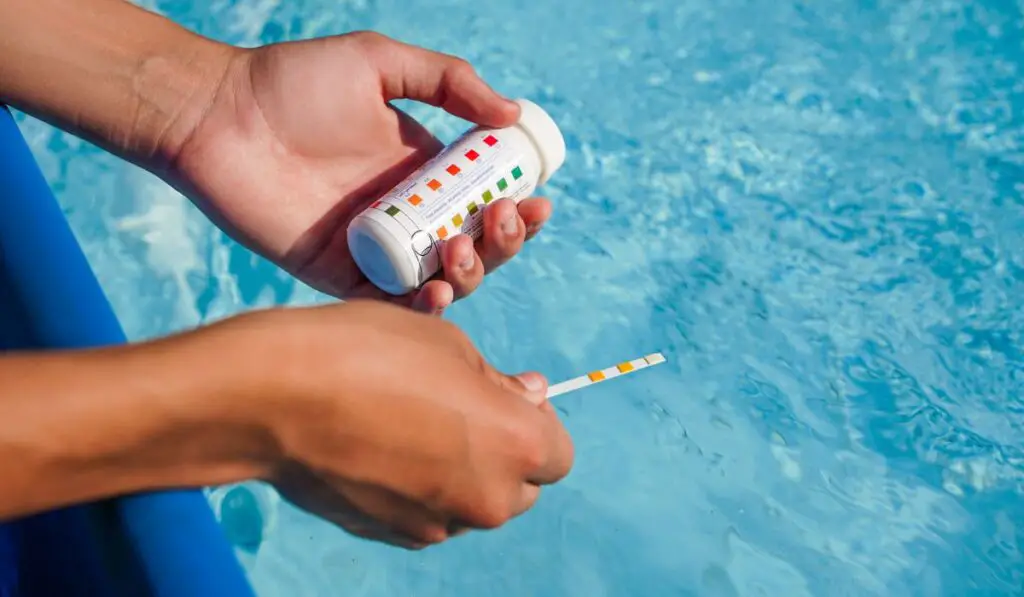As a pool owner, you have to consider the schedule of your pool pump. While you may have heard that it’s necessary to run a pool pump throughout the day, doing so will have a significant impact on your electricity bill. So, how often do you need to run your pool pump?
The recommended time to run your pool pump is about 8 hours per day, which is generally long enough to circulate all of the water in your pool at least once. To determine the exact amount of time required for pumping your pool, you need to determine your pool’s turnover rate.
The pool pump is the powerhouse of any pool, preventing stagnant water and keeping your swimming pool in great shape so that you can enjoy it. Let’s take a look at how pumps work, how often to use them, and some other important pool maintenance tips.
How Do Swimming Pool Pumps Work?

Swimming pool pumps get rid of debris and keep the chemicals blended by drawing water into the filtration system and releasing it again. Irrespective of the filter you use, it only functions if water flows through it, as that is the only way it can trap the dirt and germs.
By running the pool water through the pump’s filter at least once a day, it can be kept clean. The amount of time it takes for the water to circulate through the pump is known as the turnover rate. More on that below.
How Many Hours a Day Should a Pool Pump Run?
Numerous factors determine how long you will need to run your pool pump a day, including how often you use your pool. It is advisable to run your pool pump several times a day for short periods, starting with six hours a day but never going lower than five hours, particularly during summer.
However, if you use your pool regularly, you’ll need to run the pump for about eight hours a day, checking the water’s clearness and chemical balance relatively often.
Ultimately, to achieve the correct pool pump schedule, you need to measure your pool pump’s turnover rate.
Turnover Rate
As we mentioned above, the turnover rate refers to how the amount of time needed to run all of the water in your pool through the pump/filter system you have. This is measured with the value of your pool’s volume, either by using the pool volume calculator or a general formula.
Pool Volume
The calculator, just like the formula, works by using your pool’s shape along with the value of both the shallow and deeper depths of your pool’s water, the pool’s length, and its width.
First, you multiply your pool’s length and width to get its surface area, and then you include the pool’s depth to get your basic volume estimate.
For example:
If your pool is 20 feet x 10 feet and 5 feet deep, the volume is 1,000 cubic feet. Then 1,000 x 7.5 = 7,500. That’s your pool’s volume estimate.
It’s worth noting that different shapes of pools with different depths are more complicated to measure their volume compared to pools with constant depths.
GPH/GPM
The next step for determining your turnover rate is to calculate the gallons per hour (GPH) that need to be pumped. You can get the GPH by dividing the pool’s volume by eight. However, the turnover rate of most pool pumps is measured in gallons per minute (GPM), so you will need to divide the GPH by 60 to get the correct value.
Hence, the turnover rate formula is:
Total pool volume / 8 = GPH
Which means for our example above:
7,500 / 8 = 937.5 (GPH)
Therefore, your pool should pump 937.5 gallons per hour daily.
In order to get the GPM:
GPH / 60 = GPM
937.5 / 60 = 15.625. That is, your pool pump pumps 15.625 gallons per minute.
Another way to figure out your GPH/GPM is to simply check the specification label on the pump or browse the description on the manufacturer’s website.
Regarding the number of hours your pool pump should run daily, if its volume is 7,500 cubic meters and its GPH is 937.5, you can determine the hours by dividing 7,500 by 937.5, which equals 8 hours.
Can You Run Your Pool Pump Too Frequently?
Running a standard pool pump 24/7 depletes your money and the pump’s energy such that its engine gets unnecessarily strained. In addition, your pump gets used up faster and will need replacements of some parts or the whole component.
There is also the case of noise pollution that your neighbors have to endure with the overworked pool pump’s sound.
Should You Run Your Pool Pump When It Rains?
Yes, it can help if you run your pool pump when it’s raining, except if there’s a thunderstorm. During storm, lightning could hit an external circuit, which could spoil your pump and other components. In that case, it’s recommendable to switch off your pump or turn off the circuit breaker.
After heavy rain, there are a few things you should do to your pool and its pump to get them back to their original enjoyable state.
- Clear trash from the skimmer and pump baskets as debris can get trapped in these parts during a heavy downpour.
- Scan your pool to get rid of any more rubbish on the water’s surface. Afterward, polish and vacuum your swimming pool.
- Decrease the water level, if necessary, by using your pool pump. The average water level is halfway up the skimmer’s entrance, and the ways by which you can reduce the water level if it’s above the ideal point include:
- Set your pump to waste if you are using a Sand Filter.
- Open the drain plug to remove the extra water if you have a Cartridge or Diatomaceous Earth (D.E) Filter. Additionally, you can get an attachment for your filter to enable water to drain quickly from your pool with the hose.
- Get a submersible pump; they have adequate features to get your water at its proper level via draining in no time.
- Test your pool water and rebalance it with the help of a professional who is well versed in getting your pool water where it should be.
- Set your pump to waste if you are using a Sand Filter.
How Many Hours Should I Run My Pool Pump in the Winter?
This question isn’t going to effect most people, because normally in the winter your pump is “winterized”, and part of that process means disconnecting the pump, plumbing, and otherwise disabling the pump from running and circulating water at all. So, for most people, the answer to this question is “you can’t”!
However, if you’re someone that’s really trying to keep your pool open and operating during the winter, or maybe you plan to cover it and run it enough that there’s no chance of the water freezing, there may be a few of you out there who want to keep the pool open all winter, and if that’s the case, it’s best to run your pool no less than 4-6 hours a day in winter.
The day-to-day sequence can be split into various rotations. However, each cycle should not be shorter than 4 hours for all the water to flow through the filter simultaneously.
Other Pool Maintenance Tips

Maintaining your pool takes work and dedication. Below are a few beneficial pointers to help with that:
Test the Water Quality
You don’t need to test your pool’s water quality only after a rainstorm, you have to check the quality continually and add the proper chemicals into the water.
Furthermore, you need to maintain the chlorine level.
During the summer, you should test the water quality at least once a week or more, while during winter, you don’t need to check as often; typically, every 1-2 weeks will do. For this, you can use a test kit like the Poolmaster 22260 (on Amazon).
To avoid more pool problems, you should also know that the water’s pH level should always be between 7.4 and 7.6, never higher or lower.
Wash the Pool Filter and Clean the Pump Basket
Regular washing of the filter is paramount for a pool owner to keep it working as expected. However, you may not need to scrub it as frequently as you test the water quality or chemicals. Every three to six months is okay, depending on your pool’s conditions and the weather.
The pump basket works just like the filter to capture trash, and you need to clean it frequently (weekly at most) to avoid a decrease in water flow, especially during the fall and spring when there are higher chances of more debris in the pool.
Change Your Pump’s Shaft Seal While Replacing Its Motor
Whenever your pump fails, you should not just replace its motor but also change the pump’s shaft seal as it keeps the water out of the engine, preventing failure.
You may think this is unnecessary, but shaft seals damage with time, so if you use your old shaft seal with a new motor, they may not connect well, leading to leakage.
Inspect the Water Level
As you read above, your pool’s water level is expected to be at a certain point. The lower it gets, the more damage your pool pump experiences, causing it to get exhausted quickly.
However, higher water levels can also cause issues such that the skimmer door may not function properly. To avoid both cases, ensure you check the pool water level constantly and adjust it accordingly.
Skim and Scrub Your Pool
Skimming is an essential part of pool maintenance, and it involves removing leaves and other rubbles off your pool’s surface. You may need to do this daily to maintain your pool’s tidy appearance.
On the other hand, you don’t need to scrub your pool all the time; it can be done every other week. Ensure you use a scrub brush (on Amazon) for the pool sides, focusing on algae growth to prevent more buildup and keep your siding spick and span.
Get Your Pool Serviced Professionally
Professionals are indeed the best option for pool maintenance as they make sure everything is in good shape without missing any detail. In addition, they have a wealth of knowledge about pool equipment, including the pumps, filter, and heating components.
Maintaining your pool becomes an easy feat with their assistance.
